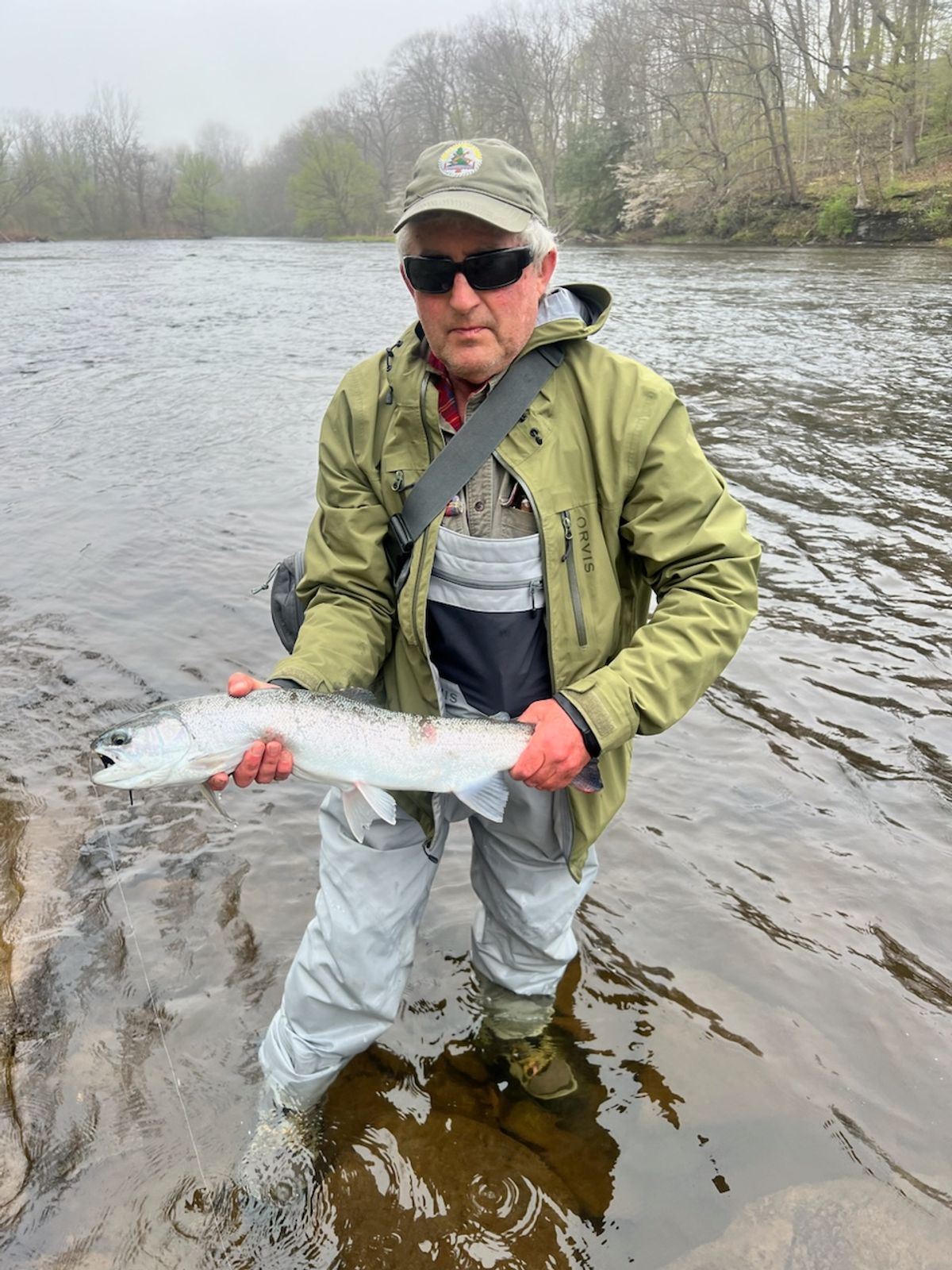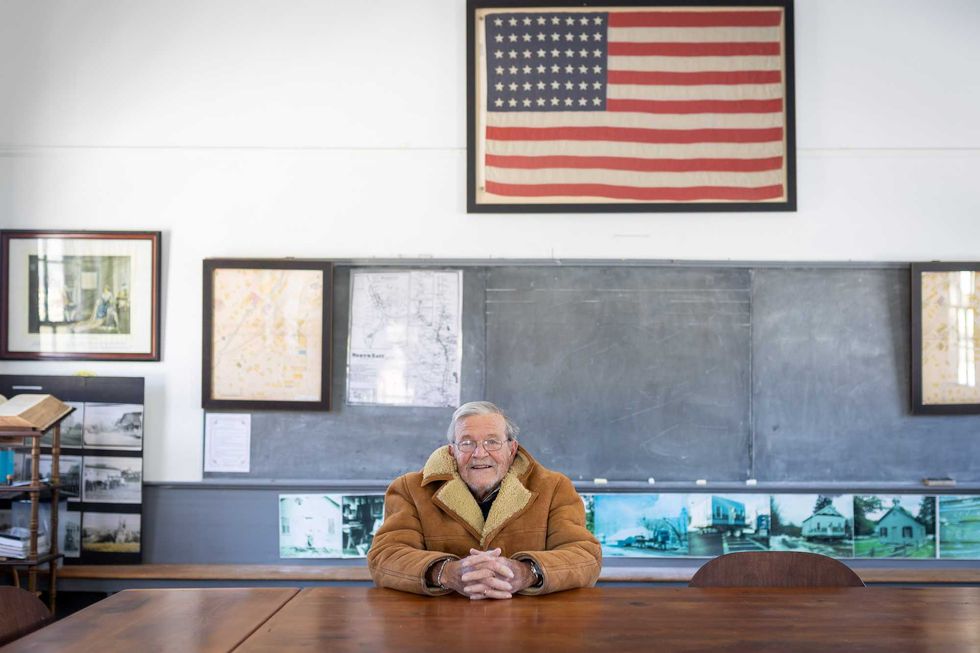Lost in the mail: Tackling the big questions

A steelhead, one could argue, is a rainbow trout on steroids.
Gary Dodson

A steelhead, one could argue, is a rainbow trout on steroids.
Let us open the Tangled Lines mailbag and see what the populi is voxing about.
Agnes Day of Spore City, Ohio writes:
You keep talking about wet flies. Aren’t all flies wet once you cast them into the water?
I could go into a detailed explanation of how the wet fly imitates a transitional stage in an aquatic insects life cycle but I won’t, because this is a family newspaper.
I will offer this anecdote:
I was about 14 and fishing Woodland Valley Creek, a tributary of the Esopus in the Catskills. Dries only. I was having some success but occasionally my fly got waterlogged and provoked strikes, especially when I was trying to retrieve it when it was submerged downstream.
I was working a pool right by a cabin. The building was so close to the stream you could fish from the porch. As I puzzled over how to get that fish that was hanging out by the lower part of the pool, the old-timer on the porch was watching me. I didn’t realize it.
He scared me out of a year’s growth when he spoke up. He asked what fly I was using. “Royal Coachman,” I said. He asked if I had a wet version. I replied, Agnes-like, “A what?”
He came off the porch and made his way to where I was perched at the top of the pool. He borrowed my fingernail clippers and cut off most of the hackle on the Royal and left the white wing.
Then he advised adding a couple of feet of finer tippet, waiting 10 minutes for things to settle down, and flopping the thing into the current, allowing it to swing through the tail out.
I did this and after a couple of false starts caught the fish that had been tormenting me.
Afterwards the old-timer said I should try fishing wet flies upstream just like dries. When I objected that I wouldn’t be able to see the fly he said “Yeah but they’ll see it, and if they see it they’ll let you know soon enough.”
Fester Karbunkle of Potzrebie, New Jersey wants to know:
Do you ice fish?
No I do not. Ice fishing involves walking gingerly out on a frozen pond or lake, cutting a hole in the ice, and staring at it for indefinite periods of time.
I want no part of it. Especially the cutting the ice part. The ice is all that is between me and a cold, watery grave AND WOULD YOU PLEASE STOP CUTTING THE %$@# ICE!
Linus J. Scrimshaw of West Cornwall inquires:
What was your best trout in 2024?
This was a difficult year, with way too much rain at some points and none to speak of at others.
So the most satisfying catch was on the East Branch of the Delaware around Margaretville, New York. The stream was very low and I had to hoof it a couple hundred yards through inhospitable terrain until I found a pool deep enough to justify the term.
I could see the trout, and they could see me. So it just turned into a grim battle. Who would give up first?
After considerable time, and several “look but don’t eat” moments, I finally got a fat brown on a Bread and Butter nymph fished naked and alone. (The fly, that is. Not me.)
Then I had to go a couple hundred yards through inhospitable terrain back to where I started. My buddy Gary had wisely stayed put and was yanking a fish in when I fetched up. His fish was better than mine.
Honolulu Jones of East Drizzle, Wyoming objects:
Wait a minute. Didn’t you catch a steelhead back in April?
Yes, and you could argue that a steelhead is a rainbow trout on steroids.
But that trip to Pulaski and the Salmon River was so completely out of the usual run of events that I think of it the way other people think of significant milestones, like marriage, or the first arrest.
I forgot half my gear, sprained my wrist turning the knob in the shower, and almost lost an earlobe when a gust of wind blew a size 4 black Wooly Bugger (with rubber legs) back into my personal face.
And after fruitlessly flogging the water for two days, I absently flipped the Bugger into a deep hole, just trying to get some line out, when the steelie loomed up and chowed down.
So no, my first and only steelhead wasn’t the best fish of 2024. It was a happy accident and nothing else.
Ralph Fedele sits at a desk in the historic Irondale Schoolhouse, which he led the effort to relocate to downtown Millerton.
MILLERTON — After serving for 12 years on the North East Town Board, Ralph Fedele says he has only one regret.
“I wish I could be called a ‘local,’” he joked with a warm, booming laugh.
Fedele moved to Millerton from New York City 37 years ago, in 1988, and has since worn many hats — volunteer, historian, advocate, elected official — yet he still doesn’t believe he’s earned that title.
“I’m a transplant,” he said matter of factly. “I’m from the city.”
Before settling in Millerton, Fedele spent 25 years working in merchandising at JCPenney.
His roots, however, trace back to Rhinebeck, where he grew up on a 97-acre farm and enjoyed what he describes as an idyllic childhood.
“It was marvelous,” he said, with a twinkle of nostalgia in his eyes. As a boy, he climbed apple trees, spent hours in the family barn’s hayloft, played with neighbors until sunset, and helped his Sicilian grandmother — his nonna — in the garden. Today, Fedele wears her ring. “Any time I’m a little depressed or I want to remember,” he said, “I can talk to her.”
Growing up with an Italian grandmother sparked a lifelong love of history and culture. That curiosity eventually took Fedele to Italy, where he visited the church in which his grandmother was baptized. “Because I love history so much, I wanted to know where my grandmother was from, so I traveled to her village in Sicily.”
Along the way, he uncovered another piece of family history. His great-grandfather, Giovanni Nicolini, was a noted Italian sculptor whose work still stands outside Palermo’s Teatro Massimo, the largest opera house in Italy. Fedele later made a pilgrimage there and photographed his ancestor’s name on the bronze plaque outside of the theater.

The Irondale Schoolhouse
Years after settling in Millerton full time, Fedele was driving north on Route 22 when he spotted an old, classic building and couldn’t stop thinking about it.
“It was in dire straits,” he recalled. “Right on the road, but beautiful. I remember thinking, ‘Wouldn’t that be a great building to move into the village?’”
That moment would eventually turn into Fedele’s lasting legacy.
He left his post at the North East Historical Society to found Friends of the Irondale Schoolhouse, leading an eight-year effort to “move, restore, and repurpose the building.”
Supervisor Chris Kennan said the project remains inseparable from Fedele’s name. “Every time I pass by the Schoolhouse, I think of Ralph,” Kennan said. “It was his vision and persistence that enabled this dream to become a reality.”
Fedele joked that people may have thought he was crazy during the lengthy restoration. “I was a tyrant,” he said with a laugh. “I really made sure that we were able to get it done.” The effort required coordination with the state, the county, village and town officials, and his newly assembled nonprofit board.
As a self-proclaimed history buff, Fedele didn’t stop at the restoration. He found a list of students in old records and did what any determined historian would do. He opened the telephone book and started making calls.
Eventually, he tracked down one of the schoolhouse’s original students — Mary (Mechare) Leitch — who, at the age of 101, returned to the building after renovations were complete.
“It was a marvelous time,” smiled Fedele. “I was so happy to see her.”
‘Trust is earned’
Today, even though he won’t call himself a local, Fedele is a familiar fixture in town. You can find him each week enjoying conversation and a cup of coffee at Talk of the Town Deli, or getting stopped in town by neighbors and friends for a chat.
“I have gained the trust and confidence of a lot of people,” Fedele said. “It comes a little bit at a time. Trust is earned.”
Not only has Fedele served as a town board member, he has volunteered for Townscape and served as the president of the North East Historical Society. He was also one of the first advocates of preserving history by fixing toppled gravestones at the Spencer’s Corners Burying Ground.
His service was formally recognized at his final Town Board meeting through a resolution commending his three four-year terms as councilman, citing his “good humor, kindness to all and deep concern for the community’s senior citizens and for those living on fixed incomes.”
An emotional Fedele addressed the room with a mantra he often repeats. “When you leave, leave this place a little bit better than you found it,” he said. “That’s what I have always tried to do.”
Neighbors react
During the public comment, several residents stood to thank Fedele.
Claire Goodman, a member of the village Zoning Board of Appeals and Townscape volunteer, said Fedele was among the first to welcome her to Millerton.
“Whether we’re standing out in the cold, scrubbing tombstones at Spencer’s Corners, or ringing the bell at the schoolhouse, you always have such grace and you’re such a gentleman.” She added, “The way you laugh, it opens my heart.”
Kathy Chow, who serves on the Conservation Advisory Council and the Climate Smart Task Force, referred to Fedele as a “pitbull,” adding, “We all have hard things that we do, and we keep pushing at it, but you’re the one who makes me think I can keep going.”
Fedele describes his retirement from the town board as bittersweet. “I’m going to miss this,” he said. “I really am.”
Mad Rose Gallery on Route 44 in the Village of Millerton is decked out with lights and decorations to celebrate the holiday season.
MILLERTON — The Village of Millerton is inviting residents and businesses to enter its annual house decorating contest, with judging now underway through Dec. 28.
Awards will be presented in several categories, including Best Lights, Most Creative, Best Overall and Best Commercial Front.
Entries will be evaluated by a panel of judges using established criteria. Creativity will be judged based on originality, variety of materials used and the use of homemade vs. commercially made decorations. Appearance will consider color coordination, balance and overall attractiveness, while effort will reflect the time and energy put into preparation and presentation.
Judging will be conducted by drive-by observation between 6 p.m. and 11 p.m., and displays must be clearly visible from the street side of the house at night. People and pets may not be included as part of the design.
Winners in each category will receive a gift basket, gift certificates and recognition in The Millerton News. Awards will be distributed on Friday, Jan. 9, 2026.
The contest is open to residents and businesses in the Village of Millerton and the Town of North East. Entry forms can be obtained from Village Hall or at villageofmillerton-ny.gov.